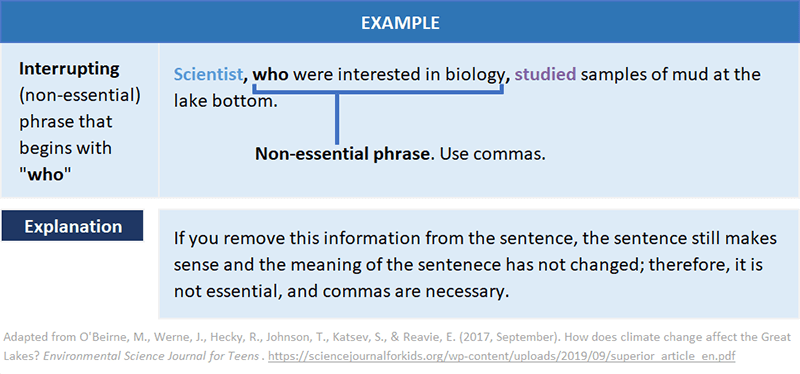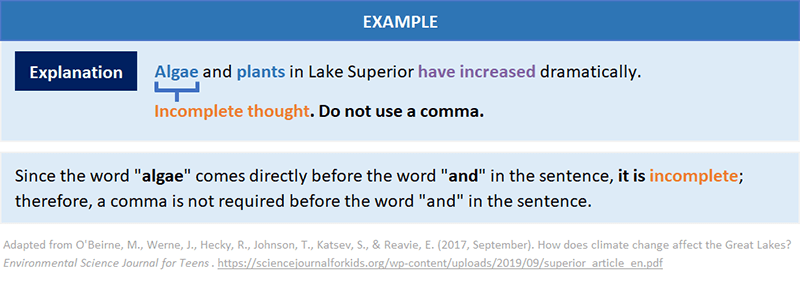23 Punctuation: Commas
Commas
There are several different reasons to use commas in a sentence. Watch the video to learn when and why to use commas.[1]
Review Comma Use
Use commas to separate items in a series or a list of three or more items.
When you list three or more items in a sentence, use a comma before each item in the list, including one before the word and, but, or or. Items in a list can include nouns, verbs, and even phrases.
| nouns | I like apples, oranges, and grapes. |
| verbs | I swim, run, and do yoga to stay in shape. |
| verb phrases | Janice drove down the street, stopped the car, and opened the trunk. |
| adjectives | She was smart, well-educated, and experienced. |
If a sentence contains a list of only two items, do not use a comma between them.

Learning Check
Determine if commas are used properly in the following sentences.
Once you have finished the Learning Check Quiz, read about how commas are used with introductory words or phrases.
Use commas with an introductory word or phrase
Sometimes a comma is used near the beginning of a sentence to let the reader know where the introductory word, phrase, or clause ends and the main idea begins.
| Introductory word | Therefore, the scientists had to end the study early. |
| Introductory phrase | According to meteorologists, smoke from forest fires creates its own weather patterns. |
Common introductory words include the following:

Sometimes a comma is used after an introductory dependent phrase before an independent clause begins.

Other times, a comma can be used after an introductory dependent clause before an independent clause begins.
Introductory dependent clauses often begin with these common subordinating conjunctions:

Tip to Remember: Do not use a comma if the sentence ends with a dependent clause.

Learning Check
Determine if commas are used properly in the following sentences.
Once you have finished the Learning Check Quiz, read about how commas are used with interrupters and appositives.
Use commas to surround interrupters and appositives
An interrupting word or phrase interrupts the flow of a sentence. Usually, when an interrupting word or phrase is omitted, the sentence still makes sense and the meaning of the sentence does not change. In other words, an interrupting word or phrase is not essential to the sentence.
| Interrupter word | Many Indigenous communities, however, never ceded their land claims. |
| Appositive phrase | My teacher, exhausted and frustrated, ended class early. |
Common interrupting words include the words however and for example.
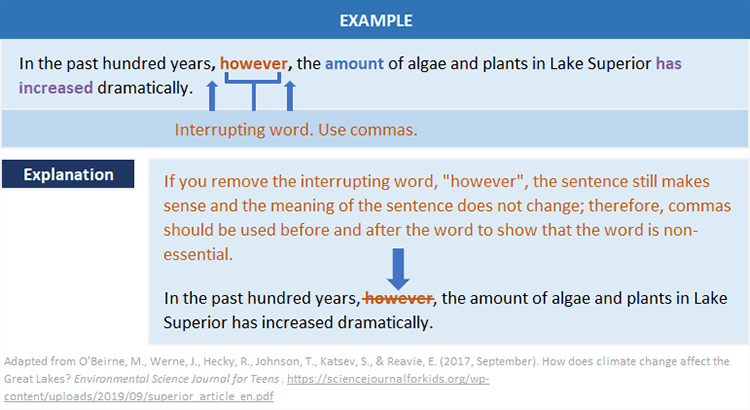
An appositive is a noun or noun phrase that describes another noun or noun phrase already mentioned in the sentence. Use commas before and after an appositive since the sentence still makes sense when the appositive is removed from the sentence and the meaning of the sentence does not change.

Learning Check
Determine if commas are used properly in the following sentences.
Once you have finished the Learning Check Quiz, read about how commas are used with interrupting non-defining clauses
Use commas with interrupting non-defining clauses
A non-defining clause adds extra, non-essential information to a sentence, You can think of it as a parenthetical phrase; the phrase could be removed without harming the grammar or meaning of the sentence.
A defining clause contains information that is critical to the meaning of the sentence.
| Non-defining clause
(with comma) |
I live near Lake Superior, which is one of the largest fresh water lakes in the world. |
| Defining clause
(without comma) |
My teacher is the woman who won the award. |
An interrupting phrase that starts with the word which is usually non-essential and requires commas. Remember, you can tell if a phrase is non-essential to the sentence if the meaning of the sentence does not change and still makes sense when the phrase is removed.
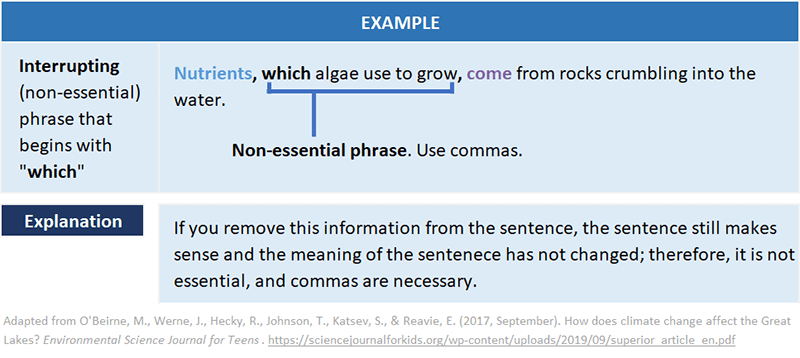
You can tell if a phrase is essential to the sentence if the meaning of the sentence is changed or no longer makes sentence when it is removed.
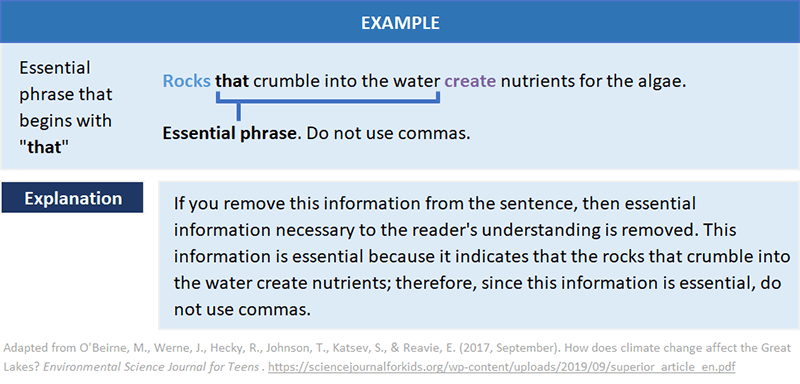
Sometimes comma are required for interrupting phrases that begin with who as well; however, a phrase that begins with who can also be essential. Be sure to check to see if the phrase can be removed from the sentence in order to determine if commas are required or not.
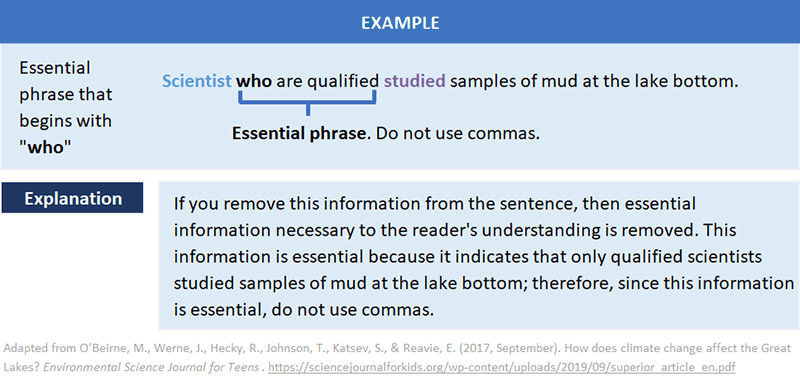
Learning Check
Determine if commas are used properly in the following sentences.
Once you have finished the Learning Check Quiz, read about how commas are used with conjunctions.
Use commas with conjunctions
You must use a comma with a coordinating conjunction (FANBOYS) when the conjunction is being used to join two complete sentences.
You use a comma with a subordinating conjunction when the dependent (incomplete) clause is at the beginning of the sentence.
| Coordinating conjunction
(with a comma to join two sentences |
I missed the final, and I didn’t complete most of the homework. |
| Coordinating conjunction
(without a comma because second half of the sentence is not complete on its own) |
I missed the final and didn’t complete most of the homework. |
| Subordinating conjunction
(with a comma because the dependent clause is at the beginning) |
Because I was sick, I stayed home. |
| Subordinating conjunction
(without a comma because the dependent clause is at the end) |
I stayed home because I was sick. |
Commas are used before coordinating conjunctions that join two independent clauses. The most common coordinating conjunctions form the acronym FANBOYS (For, And, Nor, But, Or, Yet, So).

Some sentences contain the words for, and, nor, but, or, yet, so; however, these words do not require a comma before them in the sentence because an independent clause does not come before and after the word.
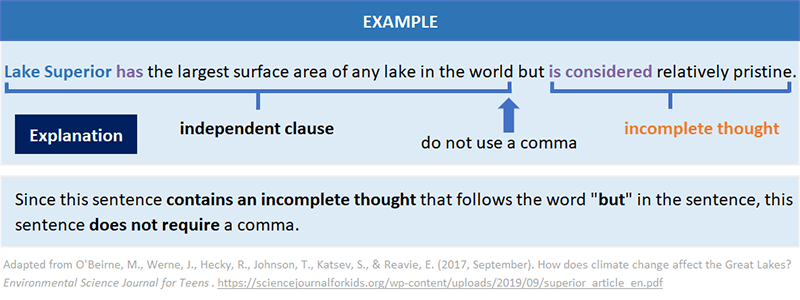
Learning Check
Determine if commas are used properly in the following sentences.
Once you have finished the Learning Check Quiz, read about how commas are used with descriptive words.
Use commas with descriptive words
Sometimes a list of descriptive words known as adjectives may appear before a noun in a sentence. You may or may not need to include a comma between a list of two or more adjectives in a sentence.
Coordinate adjectives describe the noun equally. You can put the adjectives in any order, and you could put the word “and” between them.
Cumulative adjectives build on each other and they cannot be reordered. If your have cumulative adjectives, you do not place commas between them; similarly, putting the word and between them does not work.
| Coordinate adjectives
(use a comma) |
Maria carried the wet, muddy puppy into the house.
You can reorder the adjectives: It was a muddy, wet puppy. You can put “and” between the adjectives: It was muddy and wet. |
| Cumulative adjectives
(don’t use a comma) |
I know those four red-headed girls.
You can’t reorder the adjectives or put “and” between them. |
There are two questions you must ask in order to determine if a comma is necessary between two or more adjectives:
- Does the sentence make sense if you place the word “and” between the adjectives?
- Does the sentence make sense if you reverse the order of the adjectives?
If the answer is YES to both of these questions, then a comma IS needed.
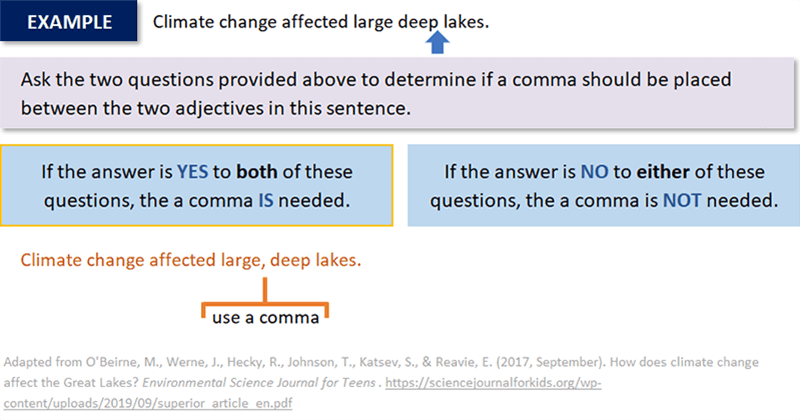
If the answer is NO to either of these questions, then a comma IS NOT needed.
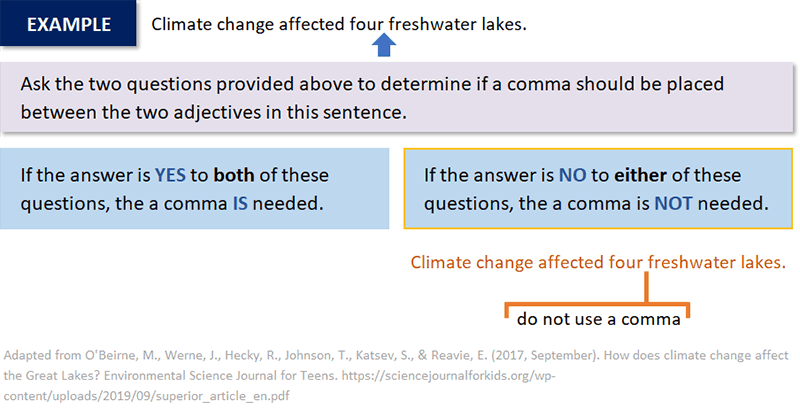
Learning Check
Determine if commas are used properly in the following sentences.
Once you have finished the Learning Check Quiz, read about how commas are in dates and addresses.
Use commas to separate elements in addresses and dates
| dates | My mom was born on July 1, 1950, in Thunder Bay.
Jeremy said he wrote his test on Friday, September 11, 2005. |
| addresses | I sent the letter to 1450 Nakina Dr., Thunder Bay, ON P7C 4W1.
Make sure you forward the mail to 1234 Parkway Ave., Toronto, ON M4B 1B4, starting tomorrow. |
Separate date and address elements with commas.
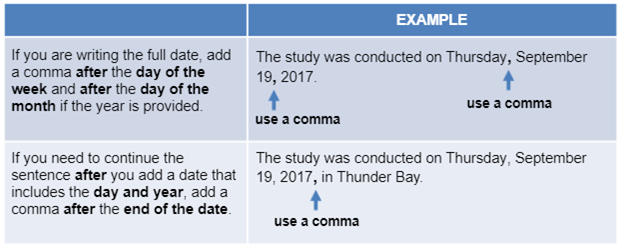
Do not use commas in any of the following situations:
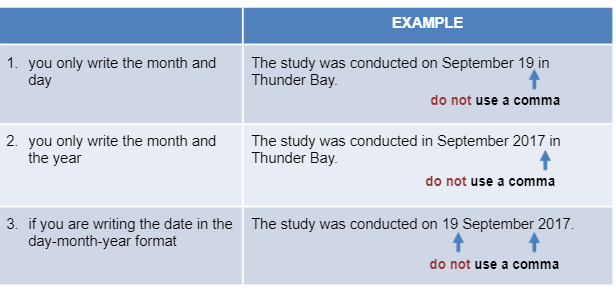
Commas in addresses:
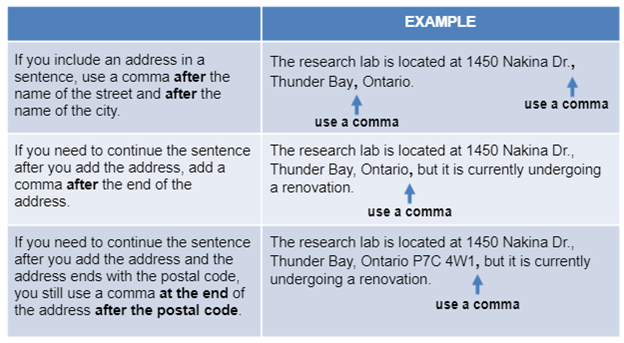
Do not use a comma in these situations:

Learning Check
Determine if commas are used properly in the following sentences.
This video gives you a chance to apply your understanding of when and why to use commas.[2]
Additional Resources
To learn more about commas
- Read Chapter 3.1 of Writing for Success [3].
- Try these online activities from OWL Purdue; complete the exercise and then compare your responses with the answer key
- Shannon, D. (2021, March 28). Commas 1 [Video]. YouTube. https://youtu.be/wLjyfbqRyiU ↵
- Shannon, D. (2021, March 28). Commas 2 [Video]. YouTube. https://youtu.be/EfHxlvMRXuE ↵
- Writing for Success is adapted from a work produced and distributed under a Creative Commons license (CC BY-NC-SA) in 2011 by a publisher who has requested that they and the original author not receive attribution. This adapted edition is produced by the University of Minnesota Libraries Publishing through the eLearning Support Initiative. ↵


